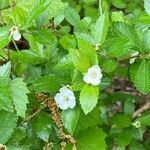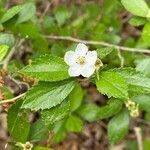Shrubs, 10–20(–50) dm. Stems: twigs: new growth densely appressed-pubescent, 1-year old brown, older grayish; thorns on twigs usually numerous, sometimes absent, ± straight, 1-year old black, needlelike, 3–5(–8) cm; ?young thorns soft, rapidly growing, needle-pointed shoots with linear bracts, often curved initially, straightening?. Leaves: petiole very short or absent, pubescent, glandular or not; blade narrowly elliptic, elliptic, obtrullate, spatulate, oblanceolate, or narrowly rhombic-elliptic, sometimes suborbiculate, (1–)1.5–3(–6) cm, length/width = 1.5 or narrower, base cuneate, lobes 0, margins crenate to serrate, teeth variably caducous, black eglandular or gland-tipped, venation semicamptodromous to camptodromous, veins 3 or 4(or 5) per side, ?± impressed?, apex obtuse to broadly acute, ?often somewhat glossy?, abaxial surface sparsely to moderately pubescent, veins ± densely pubescent, adaxial densely scabrous, especially young. Inflorescences 1–3(–5)-flowered; branches pubescent; bracteoles of two types: 1) ± persistent, green, herbaceous, margins serrate, teeth glandular, or 2) caducous, linear, membranous to herbaceous, margins glandular. Flowers 10–15 mm diam.; hypanthium strongly tomentose, (sometimes bearing a caducous, linear, membranous to herbaceous, gland-margined bracteole); sepals foliaceous, usually longer than petals, ?2–4 mm wide?, surfaces sparsely pubescent; anthers white to cream; styles 5. Pomes yellowish to ruddy, 8–10(–12) mm diam., ± tomentose; ?flesh firm, dry, or mealy?; sepals ?persistent?, patent, ?7 mm?; pyrenes 4 or 5. 2n = 51, 68.
More
A low shrub or a small tree in warmer places. It has a short stout trunk. The crown is rounded. The branches are crooked. The bark is grey-brown and smooth but becomes scaly near the base. It grows 60-150 cm high. It can be 5 m high. The trunk is 15 cm across. The leaves are 2-4 cm long by 1.2-3.2 cm wide. They are spoon shaped and broadest above the middle. There are coarse teeth and a wavy edge. The leaves are sometimes lobed. The veins are sunken. The leaves are dark shiny green and rough above and paler and hairy underneath. The flowers are 15 mm across and with 5 white petals and yellow stamens. The flowers usually occur singly. The fruit are 12 mm across. They are yellow to dull red.
Shrub 1–2 m with slender, spreading branches; twigs villous when young; lvs obovate, 1.5–3 × 0.8–2 cm, or larger and sometimes broadly elliptic or suborbicular on vegetative shoots, cuneate and often glandular at base, crenate or serrate, firm, scabrate and shining above, pubescent at least on the veins beneath; petiole stout, 2–5 mm, pubescent; fls 1–1.6 cm wide, solitary or rarely 2 together on short-pubescent pedicels; sep foliaceous, pectinate or deeply glandular-serrate; fr 0.8–1.2 cm thick, greenish-yellow or dull red, with a broad, slightly elevated cal and thin hard flesh; nutlets usually 5. Usually in sandy or rocky ground; L.I. and Pa. to Fla., w. to O., Mo., and e. Tex.


